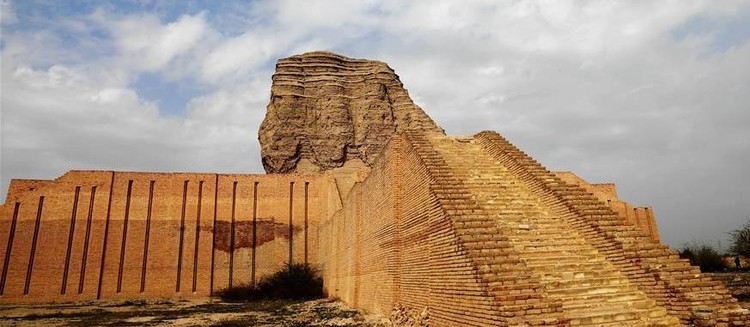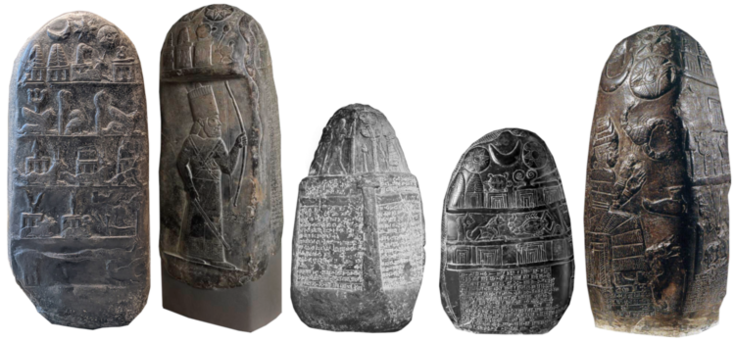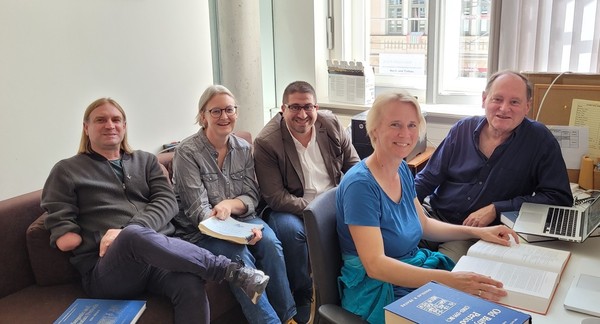Royal Inscriptions and Kudurrus of the Kassites (RIKK)
 View of the once-towering ziggurat at Dur-Kurigalzu, modern Aqar Quf (January 2019).
View of the once-towering ziggurat at Dur-Kurigalzu, modern Aqar Quf (January 2019).
More than 250 Akkadian and Sumerian royal inscriptions and 135 inscribed kudurrus (‘boundary stones’) from the Kassite Dynasty of Babylon (ca. 1595–1155 BC) are presently known. J.A. Brinkman systematically catalogued all of the Kassite royal inscriptions available to him up to 1977 in his A Catalogue of Cuneiform Sources Pertaining to Specific Monarchs of the Kassite Dynasty (Materials and Studies for Kassite History 1), but this important group of Middle Babylonian texts has not yet been edited and translated in a single volume. Such an endeavor had been planned in the 1980s and 90s by the now-defunct, University-of-Toronto-based Royal Inscriptions of Mesopotamia (RIM) series. However, RIM ended long before its ambitious Babylonian Periods sub-series (RIMB) could be completed. On the other hand, L.W. King published English translations of the boundary stones housed in the British Museum (London) in his 1912 volume Babylonian boundary-stones and memorial tablets in the British Museum, but that book has long been outdated. While Susanne Paulus edited all known kudurrus in her 2014 Die babylonischen Kudurru-Inschriften von der kassitischen bis zur frühneubabylonischen Zeit. Untersucht unter besonderer Berücksichtigung gesellschafts- und rechtshistorischer Fragestellungen (Alter Orient und Altes Testament 51), those texts have yet to be fully translated into English, as well as be made accessible in a fully annotated (linguistically tagged), open-access digital format. As there is a growing need to make this important group of ca. 400 texts from the second millennium BC more accessible, in both print and online formats, the time is ripe to prepare a three-volume authoritative presentation of the Royal Inscriptions and Kudurrus of the Kassites (RIKK).
This new publication project aims to provide editions, with English translations, of the complete corpus of Akkadian and Sumerian inscriptions of the Kassite period and the Akkadian-language kudurrus that were written during that same period of time. Following the models of the Royal Inscriptions of the Neo-Assyrian Period (RINAP), Royal Inscriptions of the Neo-Babylonian Empire (RINBE), and the Royal Inscriptions of Assyria (RIA), the planned series consists of three volumes that will include:
- comprehensive introductions, including information about the historical and geographical contexts of the texts, discussions of the material supports of the inscriptions, and surveys of previous research;
- illustrations in the form of photographs (especially of inscribed objects) and drawings (such as annotated site plans and maps); and
- complete indexes of names of people, places, deities, and temples.
Adopting the editorial principals of the RINAP, RINBE, and RIA series, the RIKK series’ volumes will edit each text separately and in their entirety. This is particularly important for the royal inscriptions since that body of texts has never been systematically edited in a single place.
 Five kudurrus (‘boundary stones’).
Five kudurrus (‘boundary stones’).
The arrangement of texts for each Kassite ruler will be presented following the model of RINAP, RINBE, and RIA, all of which group each corpus by provenance and material (e.g., clay, stone, metal); whenever possible, the texts will be presented chronologically (from earliest to latest). Each text will be accompanied by an introduction, a catalogue of witnesses, a commentary, and an extensive bibliography. The transliterations and English translations will conform to the high standards established by RIM and its successor publications. In particular, the books’ authors will ensure the translations match the editorial practices of those aforementioned projects. The editions will also include detailed notes on the reading of certain cuneiform signs and the interpretation of difficult to understand passages, in addition for many photographs of original Kassite artefacts.

The project’s print publication and online plans took formal shape in June 2022, when RIKK’s founder and director Karen Radner (Chair for the Ancient History of the Near and Middle East at LMU Munich), in consultation with Grant Frame (University of Pennsylvania), established the project’s editorial board, its team of consultants, and the books’ authors. RIKK is part of the Munich Open-access Cuneiform Corpus Initiative (MOCCI) and a direct successor of the University-of-Toronto-based Royal Inscriptions of Mesopotamia (RIM) Project (1980–2008), drawing on expertise gained through the Royal Inscriptions of the Neo-Assyrian Period (RINAP) Project (2008–23) and the Royal Inscriptions of the Neo-Babylonian Empire (RINBE) Project (2018–).
From February 2023 to January 2030, RIKK will assemble a complete and authoritative modern presentation of the entire corpus of the royal inscriptions and kudurrus of the Kassites, both in three print volumes and in a fully annotated (linguistically tagged), open-access digital format. In addition, its core data, with substantial contextualization and metadata and linkage to external resources, will be disseminated online for free. The open-access, online facilities — which will be accessible on the Open Richly Annotated Cuneiform Corpus (Oracc) platform — include:
- a catalogue searchable by museum numbers, excavation numbers, primary publications, etc.;
- browsable text editions, with English translations;
- exportable JavaScript Object Notation and TEI versions of the corpus,
- Akkadian and Sumerian glossaries, and index of names;
- a search facility to explore texts by transliteration, words, names, as well as by English translations;
- a glossary which will provide a guided search and concordance of all instances of every word; and
- introductory pages giving historical background and other kinds of information.
As part of MOCCI, RIKK’s contents will be fully integrated into Oracc, the Cuneiform Digital Library Initiative (CDLI), and the Ancient Records of Middle Eastern Polities (ARMEP) map interface, a LMU-Munich-developed, web-based research tool. The online material is managed by Alexa Bartelmus and Jamie Novotny. The print publications are handled by Eisenbrauns, an imprint of Penn State University Press, and appear in the same format as the RINAP, RINBE, and also RIA publications. Thanks to a Golden Standard Open Access agreement with the publisher, PDFs will be available for free download without an embargo period directly upon print publication.
Planned Publications
In addition to its inclusion in MOCCI’s open-access, Oracc-based website Royal Inscriptions of Babylonia online (RIBo), the RIKK Project will produce three books and open-access PDF versions of those reference volumes, thus making reliable editions of this important group of texts freely available to scholars, students, museum personnel, and the general public. The planned publications are:
- Grant Frame and Alexa Bartelmus, The Royal Inscriptions of the Kassite Kings (scheduled for 2026).
- Alexa Bartelmus, Kudurrus of the Kassite Period, Part 1 (scheduled for 2028).
- Alexa Bartelmus, Kudurrus of the Kassite Period, Part 2 (scheduled for 2030).
RIKK Editorial Board
- Karen Radner (Ludwig-Maximilians-Universität München; director)
- Grant Frame (University of Pennsylvania)
- Jamie Novotny (Ludwig-Maximilians-Universität München; editor-in-chief)
- Anmar Abdulillah Fadhil (University of Baghdad)
- Barbara Helwing (Vorderasiatisches Museum)
- Jon Taylor (British Museum)
- Ariane Thomas (Louvre Museum)

RIKK Editorial Board and Authors. From left to right, Novotny, Radner, Fadhil,
Bartelmus, and Frame (August 2022).
RIKK Consultants
- Timothy Clayden (University of Oxford)
- A. Kirk Grayson (Professor Emeritus University of Toronto)
- Steve Tinney (University of Pennsylvania)
- Niek Veldhuis (UC Berkeley)
RIKK Authors
- Alexa Bartelmus (Ludwig-Maximilians-Universität München)
- Grant Frame (Professor Emeritus University of Pennsylvania)
Funding
RIKK receives funding from:
- The Deutsche Forschungsgemeinschaft (through the award of a Gottfried Wilhelm Leibnitz Prize for Karen Radner in 2022); and
- Ludwig-Maximilians-Universität München.


